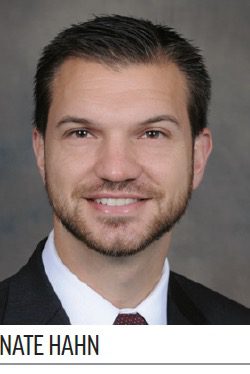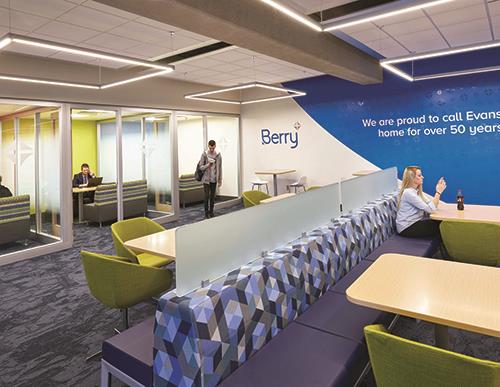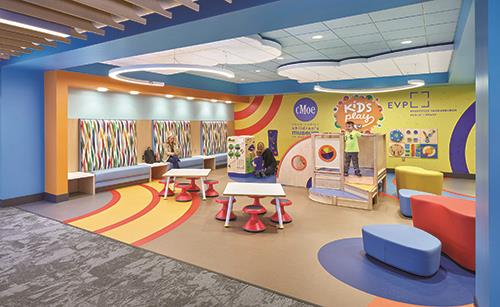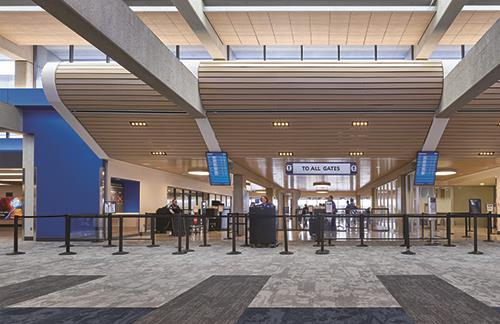Even though the terminal at Evansville Regional Airport (EVV) was more than 30 years old, personnel there still called it the new building because it replaced the airport’s original 1928 terminal. So after crews finished a major runway rehabilitation in 2015, Airport Executive Director Nate Hahn quickly turned his focus to making the “new building” live up to its name.
 Even though the terminal at Evansville Regional Airport (EVV) was more than 30 years old, personnel there still called it the new building because it replaced the airport’s original 1928 terminal. So after crews finished a major runway rehabilitation in 2015, Airport Executive Director Nate Hahn quickly turned his focus to making the “new building” live up to its name.
Even though the terminal at Evansville Regional Airport (EVV) was more than 30 years old, personnel there still called it the new building because it replaced the airport’s original 1928 terminal. So after crews finished a major runway rehabilitation in 2015, Airport Executive Director Nate Hahn quickly turned his focus to making the “new building” live up to its name.
In just 18 months, the southwest Indiana airport and its partners completed a $20 million update. In addition to constructing a small addition to provide more office space, they also overhauled the building’s interior design, customer conveniences and overall functionality.
The project’s key design partner, Hafer, also designed EVV’s original 1988 terminal.
“The airport is an integral part of the economic development efforts in the Tristate area,” says Jeff Justice, the company’s president. “It serves as a front door to our region, and the modernization project has enhanced the flying experience for passengers with improved amenities, enhanced security measures and efficiency of flow.”
|
facts&figures Project: Terminal Renovation/Expansion Location: Evansville (IN) Regional Airport Construction: Nov. 2017-Dec. 2018 Cost: $20 million Funding: $8.9 million FAA Airport Improvement Program Grant; $5 million Indiana Regional Cities Initiative Grant; about $6 million in airport funds Design: Hafer Associates, PC Consultant: CHA Consulting Contractor: Weddle Bros. Building Group LLC Electrical: Boyd Electric Skylight: Kalwall Key Benefits: Add modern amenities; update design elements; increase energy efficiency; improve passenger flow |
The company originally began the project in 2013 by reimagining the terminal’s future and providing concept imagery and preliminary cost estimates; but the runway work was a higher priority. A few years later, however, Indiana provided the incentive EVV needed to take the next step—a tax amnesty program that would feed millions of dollars into an Indiana Regional Cities Initiative.
The airport and 14 other entities became important pieces of Indiana’s $42 million Great Southwest Plan, and EVV received $5 million in funding. “Once we knew that was in play, we really kicked our plan into high gear,” says Hahn.
The FAA Airport Improvement Program contributed another $8.9 million, and the airport provided about $6 million.
The result was, indeed, a new terminal—brighter and more spacious, with remodeled ticketing counters, updated concourses and new passenger amenities. In addition to modern touches such as charging stations for electronics and filling stations for water bottles, the airport added energy-efficient chillers, variable fan drives, LED lights and other upgrades to decrease its energy bills and improve system functionality.
Exterior improvements have also been impactful. Justice notes that the revamped front entrance and new landscaping make an astounding first impression on travelers. Separating pedestrian and vehicle traffic was another marked improvement.
Matt Hoon, project manager with Weddle Bros. Building Group, reports that the terminal overhaul turned out just as the airport and Hafer envisioned. “It’s a great win for the collaborative team,” he says.
“Personally, hearing direct or indirect compliments of how wonderful EVV looks is a highlight,” Hoon adds. “And this project had zero safety incidents for some very tricky tasks. I am very proud of my team.”

Redefining Spaces
The only addition to the terminal footprint was for new administrative office space. The new facilities provide a more efficient space for airport staff and free up square footage in the terminal for passenger amenities.
 One particular design goal was to add transparency through the terminal. New glass walls allow families and friends to see into the secure side of the terminal and the airfield. “People enjoy being able to watch the planes take off and see loved ones arrive,” says Justice.
One particular design goal was to add transparency through the terminal. New glass walls allow families and friends to see into the secure side of the terminal and the airfield. “People enjoy being able to watch the planes take off and see loved ones arrive,” says Justice.
The TSA checkpoints were another primary focus. Previously, the airport had two lanes at opposite ends of the terminal. Neither had modern technology, and sharing staff between the two was tricky, notes Hahn. Today, the airport has a centralized checkpoint with two lanes featuring updated equipment. Project designers allowed room for a third lane when traffic growth requires it.
The new checkpoint is also brighter and more open and inviting. “No more gray on gray on concrete,” Hahn jokes. Justice points to the large wood ceiling, new floor tiles and recomposure area as huge improvements in design and function.
Open architecture, LED lighting throughout the building and natural light from a building-length skylight have made a world of difference. Hahn explains that the Kalwall skylight looks like glass, but is much lighter and refracts light more effectively. “It’s better in every way,” he raves. “It’s cheaper than a full-glass system, and we’re not fighting leaks anymore.”
“It’s a beautiful area we are all proud of,” Hoon agrees. “EVV is now more modern, appealing and accommodating for today’s travelers.”
Passenger-Focused Amenities
A new canopy between the terminal and parking lot makes the 100-yard dash from one to the other much easier in rough weather; and the animal relief area is an extremely popular addition for passengers traveling with “man’s best friend.” But the new restaurant, business lounge and kids’ play area top the chart of recently added amenities.
The Iron Compass café and bar is named for the way early pilots used railways to track their courses between locations. “The space has a special feel,” Hahn says, referencing the 1960s photographs of Evansville that cover the walls. “It went from feeling like an outdated diner to a modern eatery that embodies the history of the city and airport.”
With the addition of about 4,000 square feet for administrative offices, space in the terminal was repurposed for amenities such as a nursing room and a work lounge with private meeting areas. Discussion about features for the work lounge led the team to decide that all passengers would likely appreciate free Wi-Fi and workstations. So instead of adding an elite members-only lounge, the airport built an area that provides space for business travelers and other passengers who just need a space to refresh. “EVV wanted all passengers to feel like VIPs,” explains Hahn.
The airport also revamped its children’s play area with help from the Children’s Museum of Evansville and Evansville Public Library System. Hahn notes that the new area is much more interactive, and kids especially enjoy the magnetic wall and an animated version of downtown Evansville.

“We truly tried to find a way to provide all the things someone would expect in a large airport and still be Evansville,” he explains. “We know who we are, who our passengers are and wanted to be accommodating to them and meet their expectations.”
The airport recently picked up service from Allegiant Air to increase its appeal for leisure travelers. Hahn explains that the new routes will help EVV increase its reach into the vacation market. (American, Delta and United also serve the airport.)
“We talk about the family side of things, but this airport is a huge economic engine for the community,” Hahn specifies. “When we get more flights, it’s good for everyone.”
Between business and leisure passengers, 250,000 travelers passed through EVV last year. Notably, traffic at the airport has increased 35% since 2016, and its airfares have dropped 11% over roughly the same period.
Key Takeaways
The airport broke ground on its terminal modernization program in November 2017 and toasted the new facilities in December 2018. Construction was completed in stages, starting with the administrative office addition.
In retrospect, Hahn says that he and the team did well gathering input, but could have done better. For example, information was gathered about what equipment the restaurant would need, but not about specifically where items would be placed to maximize operations. The same was true for rental car operations. “I think we did some things the right way by asking, but the more input you can get from both the public and tenants is helpful,” Hahn reflects. “I wish we would have asked for more detailed information.”
He also advises including deadlines when seeking input. “We wanted to be accommodating, but should have added ‘by next Friday’ so we weren’t delayed.”
Another bit of hindsight: Sometimes construction crews had to push hard to meet timing restrictions associated with grant funding, when just six more months in the schedule could have provided breathing room for the entire project team.
Hoon adds that constant coordination with contractors was key to maintaining the safest environment possible for travelers and airport employees.
“There was heavy demo and construction traffic for most of the job,” he recalls. “It was our obligation to make sure no one was put at risk—construction trades are trained for this. And we understood that travelers had flights to catch, business to attend to and family to visit.”
Justice emphasizes the importance of phasing the construction work and maintaining a definitive line between secure and public areas. “Everyone worked well together to make sure the airport remained completely operational the entire time,” he notes.
Consolidating two TSA checkpoints into one required extra security measures. Managers from project consultant CHA, Hafer Design, Weddle Bros. Building Group and Boyd Electric held several in-depth meetings to plot the strategy in advance. “Due to the team collaboration, it was a major success,” Hoon reports.

Looking back, Hahn says that his personal experience relocating to Indiana from Midland, TX, taught him how to plan at least 10 years out. As a result, he suggests telling architects, engineers and designers, “Don’t tell me what I need now. Plan for the future; make space.”
Regarding EVV’s future, Hahn knew that it was important to build flexibility into the terminal modernization project and continually stressed that to the design team. Meanwhile, excitement abounds about recent improvements. Passengers say the terminal is brighter, easier to navigate and just more fun. Airport personnel are also enjoying the “new building”—and looking forward to occupying it for another 30 years.
|
This Amenity Brought to You by….. The recently renovated terminal at Evansville Regional Airport (EVV) is filled with concrete evidence of local support. Numerous new amenities were made possible by direct financial sponsorships from local companies: • Animal Relief Area – Midwestern Pet Foods • Mothers’/Nursing Room – Deaconess Women’s Hospital • Business/WiFi Lounge – Berry Global (an international packaging manufacturer headquartered in Evansville) • Children’s Play Area – Children’s Museum of Evansville and Evansville Public Library System Executive Director Nate Hahn explains that the new spaces and names that adorn them were a way to bring the community into the airport. “These companies wanted to greet people as they arrive and leave a lasting reminder as they depart,” he relates. While the associated funding helped offset expenses such as furniture and other necessarily equipment, Hahn says that the sponsorships weren’t meant to simply be a way to pay for new spaces. “They are Evansville-centric companies, even the multi-billion dollar ones, that you could not see in any airport,” he explains, adding that the unique partnerships offered a way for planners to get creative. The chair in the mother’s room, for instance, is the same style that is found at the Women’s Hospital. For the new play area, working with the Children’s Museum and Public Library created a well thought-out and designed space for kids to play, Hahn adds. “In my opinion, that community involvement goes a long way.” |



